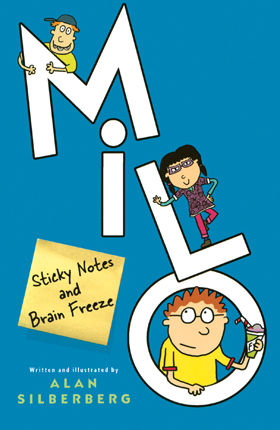Full Text Reviews: School Library Journal - 09/01/2010 Gr 5–8—By page 14, readers will know that this is more than just another funny story about a middle school misfit who is the new kid in the neighborhood. While Milo does struggle with all the normal tween anxieties and self-consciousness about his family, there is more. Silberberg details the daily events with Wimpy Kid-like drawings and quick-witted humor that will keep the pages turning. Milo's new friendships with classmates Marshall and Hillary and elderly neighbor Sylvia Poole allow readers to glimpse at the deeper truth—Milo's mother's death—as it emerges between laugh lines. Silberberg takes on a tough topic and always stays true to the age of the character through dialogue and artwork while maintaining that wisecracking, 12-year-old humor. Added to this, he manages to convey Milo's pain and fears without ever becoming maudlin or depressing. Those familiar with Silberberg's Pond Scum (Hyperion, 2005) will recognize the similar style of writing. Yet with Milo, the author embraces a core childhood fear, molding the humor with poignancy to create a profound slice of one boy's life.—Tina Hudak, St. Albans School, Washington, DC - Copyright 2010 Publishers Weekly, Library Journal and/or School Library Journal used with permission. Bulletin for the Center... - 11/01/2010 Milo is an introspective geek with strong opinions and serious unresolved grief issues-he is mourning the loss of his mother, who died of brain cancer, and his father, who has become depressed and lost in the aftermath. He has a teenaged sister as well, but they hardly interact, and she gets very little of his attention. Instead, he focuses on his move to yet another new school, where he has developed a close friendship with a fellow geek named Marshall, and then, after an initial misunderstanding about her intentions, with a girl named Hillary. He, Marshall, and Hillary start to hang out, and it is to Hillary that Milo first talks about his mother. His elderly neighbor Sylvia also aids his grief work, as she explains the importance of keeping happy memories alive. Milo’s emotional states are realistically portrayed throughout: while his sadness simmers at a slow and steady burn, manifesting most often as irritation with things that aren’t the same as when his mom was alive, his grief surfaces without warning, triggered by random events and objects that suddenly remind him of her. He shuts down, says mean things to his friends, and practices the avoidance tactics he’s learned from his dad, but his friends, with the endearing nonchalance of tweens who don’t quite know how to help a friend who’s hurting, are adept at waiting out the mood swing and moving on. The story’s mood ably mirrors the emotions of a seventh-grade boy suffering the loss of the most important relationship in his life, offering an age-appropriate model for direct emotionality. Offsetting the emotional drama is the droll humor, augmented by line illustrations that present Milo and his friends and family as cartoonish nerds in various humiliating situations; the result is a book that effectively balances the pathos of working through a serious grief with the comedy of working through the absurdity of middle school. KC - Copyright 2010 The Board of Trustees of the University of Illinois. Loading...
|



